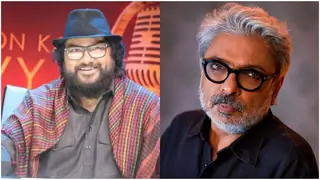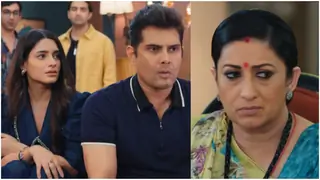| Balance of Power: The Lata-Asha sibling revelry |
| By Screen Weekly, September 29, 2006 - 06:43 IST |
| For decades, the Mangeshkar sisters – Lata Mangeshkar and Asha Bhosle – have represented the epicentre of 'playback power'. From the 1950s to the mid-'80s in particular, the male arena was the fiefdom of a handful of master vocalists, but neither Geeta Dutt, Shamshad Begum and Suman Kalyanpur nor anyone else could make a dent in Lata's and Asha's supremacy and popularity. The media made much about the love-hate relationship between the two September Siblings , but the sisters have always laughed away the alleged rivalry as a frivolous fetish of the Fourth Estate and a vicarious wish of vested interests. The two Sultanas of sur thus had the perfect balance of power. If Asha Bhosle led in the number of total recordings as well as by a huge margin in Marathi films and the Marathi non-film segments. Lata's lead was more in terms of working for the heavyweight music makers and top leading ladies of Hindi cinema. In the non-film Hindi segment, Lata Mangeshkar has largely stuck to devotionals, light songs and the occasional ghazal album, whereas Asha's middle-name has been experimentation with a gamut from ghazals and classical collaborations to Indipop and albums with Western music groups. Analysing the Divas. ASHA IN LATA'S TERRAIN: Lata Mangeshkar's sweep on Hindi films, especially from the '50s, was so complete that after outclassing the existing top female singers she became a fixture with music directors as varied as Naushad, C.Ramachandra, Madan Mohan, Chitragupta, Salil Choudhury and finally, the men who dominated the music scene till the late '60s - Shankar Jaikishan, despite her famous rift with Shankar. Most of these music makers barely looked beyond Lata, and Asha was a sporadic outing - check C.Ramachandra's 'Phoolon ke mele...' (Devta) and 'Dekh hamein awaaz na dena...' (Amar Deep), a rare Madan Mohan film like Neend Hamari Khwab Tumhare and a one-off chartbuster like 'Jhumka gira re...'(Mera Saaya), Chitragupta's 'Jodi hamari...'(with Manna Dey/Aulad) or Naushad's later films like Ram Aur Shyam and Ganwaar. It is virtually impossible to recall a Salil-Asha song worth its weight vis--vis his Lata stunners all the way from Madhumati to Chhoti Si Baat except for the 'populist' Asha-Yesudas duet from this last film. As for Shankar Jaikishan, though Asha sang so many memorable songs, the cream always went to Lata, despite a 'Sooni sooni saans ke sitar par...' (Lal Patthar) here and a 'Dhaani chunari pehen...' (Hare Kaanch Ki Choodiyan) there. The men who took over the S-J mantle - Laxmikant Pyarelal - too did give Asha the occasional humdingers from 'Khat likh de saanwariya ke naam babu...' in Aye Din Bahaar Ke to 'Hungama ho gaya...' (Anhonee) and more. But their obsession remained Lata - come cabaret, disco or semi-classical numbers. Also in Lata terrain were top stars like Nargis, Vyjayantimala, Meena Kumari, Waheeda Rehman, Nutan, Sadhana, Mala Sinha, Saira Banu and Raakhee. Some of these stars reportedly even had Lata's playback voice as a pre-condition in their contract agreement! Of course, this does not mean that Asha had no worthy songs for them. But it was a landslide lead for Lata all through. Among male co-singers, Mukesh and Talat Mehmood had an overwhelming lead in duets with Lata, led particularly by the Lata-Mukesh duets for Shankar-Jaikishan, Laxmikant-Pyarelal and Kalyanji-Anandji. And in the bhajan/devotional arena of Hindi films, there was another Lata grandslam - the devotionals of consequence by Asha Bhosle can be counted on the fingers of one hand, and include the classic 'Tora man darpan kehlaaye...' (Kaajal) and 'Saancha naam tera...' (with Usha Mangeshkar/Julie) and a few lesser songs like 'Acche samay pe tum aaye...' (Bidaai) and 'Kaun kahe apno ke kaam...' (with Kishore/Raampur Ka Lakshman). LATA IN ASHA TERRITORY: For Asha Bhosle, it was S.D.Burman's early grooming that helped a lot, but it was only when she encountered a phenomenon named O.P. Nayyar (who had reportedly sworn never to work with Lata) that Asha really thundered into her own and went beyond idol Geeta Dutt and songs for vamps and comediennes. With Dada Burman, ironically, Asha's cream came mostly in that six-year period between 1957 and 1962 when he had a personal-cum-professional rift with Lata Mangeshkar. However, Nayyar remains Hindi cinema's only major force who never recorded a single song with Asha's elder sister. And Asha's record was finally set right by R.D.Burman when despite his multiple nuggets with Lata Mangeshkar from Chhote Nawab to Libaas, it was Asha who got the exotica that made her zoom forward as the voice of choice of the modern film heroine of the '70s - Zeenat Aman, Neetu Singh and Parveen Babi - and gave her an identity beyond being just Helen's voice or mere Nayyar's muse. Lata Mangeshkar had her Helen moments too, but they were few and far between, like 'Aur mera naam hai Jameela...' (Night In London), 'Aa jaan-e-jaan...' and 'Mehfil soyi...' (Intequam) and 'Iss duniya mein jeena hai to...' (Gumnaam). And so these were also virtually Lata's only intrusions on Asha's fiefdom - the cabaret. As for Zeenat, the few highs (Satyam Shivam Sundaram and Roti Kapada Aur Makaan heading a list that also included Heera Panna, Don, Ajnabee and a few others) with Lata were swamped in the Asha deluge. Lata's few good songs for Neetu Singh (like 'Nahin nahin jaana nahin...' from Zinda Dil), and the rare Parveen hit (Kranti, Arpan, Khuddar, Kaala Patthar) were restricted largely to either L-P's prolific output or Rajesh Roshan's affinity to Lata in the late '70s. The third 'champion' of sorts for Asha was Bappi Lahiri, but that was chiefly for '80s heroines like Sridevi, Jaya Prada and Meenakshi Seshadri. There was lots of quantity there, but the calibre was generally below par. As Lata reduced her quantum of work completely from the '90s, Asha continued to sing for the young Turks like Shankar-Ehsaan-Loy, Viju Shah, Sanjeev-Darshan, Sandeep Chowta, Jeet-Pritam (and later Pritam solo) , music makers who have never recorded with Lata in their films, but did get Asha to enter their recording rooms. SIBLING REVELRY: Lata and Asha however struck an equal score with some other young composers, especially Jatin-Lalit, A.R.Rahman and Vishal Bhardwaj. The senior composers who achieved that kind of balancing act included Kalyanji-Anandji, Ravi and Hemant Kumar. Mohammed Rafi and Kishore Kumar, and Usha Mangeshkar among the females, were singers with near-equal scores with both. Mumtaz, Asha Parekh, Sharmila Tagore, Hema Malini, Rekha, Reena Roy, Jaya Bachchan and Sridevi (in her non-Bappi Lahiri films) were heroines in whose songs we also witnessed an equilibrium in the two-pronged Mangeshkar power. LET'S DUET: Statistically, the two sisters have collaborated in about 75 songs, the last one of note being 'Aaina hai mera chehera...' with Suresh Wadkar in Aaina (1993) under Dilip Sen-Sameer Sen and written by Sameer. Their first duet, in all possibility given Hindi cinema's predilection for poorly-maintained records, was 'Yeh rookhi rookhi hawayein...' from Daaman (1951) composed by K.Datta and written by Rajendra Krishan, and the first song of note was S-J's 'Manbhavan ke ghar...' (Chori Chori/1955) under Shankar Jaikishan. Lata and Asha frequently shared the microphone along with other singers as company, like sister Meena Mangeshkar in 'Banno ke haath bhari mehndi...' (Chandni Chowk / Roshan), Mohamed Rafi in 'Muqabala humse na karo...' (Prince / Shankar Jaikishan), Mahendra Kapoor in 'Pyar zindagi hai...' (Muqaddar Ka Sikander / Kalyanji-Anandji), Kishore Kumar and Manna Dey in 'Sun le pyar ki dushmun...' (Pyar Kiye Jaa / Laxmikant-Pyarelal), Laxmikant in 'Aag se aage...' (Jalte Badan / L-P) and finally Usha Mangeshkar in 'Hamre aangan bagiyaa...' (Teen Bahuraniyan/K-A), 'Dulhan maike chali...' (Manoranjan / R.D.Burman) and earlier 'Mubarak hai woho dil jis pe...' (Benazir / S.D.Burman) and 'Khile hai sakhi aaj...' (Grihasti / Ravi). Among other music directors who have orchestrated Mangeshkar Double Bills are Asha's son Hemant Bhosle (who brought mother and aunt together in his debut film Taxi Taxie in the song 'Laayi kahaan yeh zindagi...' ), Naushad, Madan Mohan, Roshan and Hemant Kumar, with the bulk of the share going to S-J and L-P. The distinction of having more than one duet (with both proving hits in both cases) is shared by Mother India's 'Mere mehboob mein kya nahin...' and 'Jaaneman ek nazar dekh le...' (Naushad) and Utsav's 'Man kyoon behka...' and 'Neelam pe nabh chhayi...' (L-P), the last two being among the most exquisite duets on which they ever collaborated. C.Ramachandra's 'Ae chand jahaan woho jaaye...' (Sharda/1957) was a rare scintillating output from this Lata-devotee composer, as was the classicism-studded Madan Mohan duet 'Jab jab tumhein bulaya...' (Jahan Ara) and that simple but toweringly-excellent song 'Pad gaye jhoole...' from Roshan's Bahu Begum. In contrast, Hemant Kumar's 'Kabhi aaj kabhi kal...' from Chand was of humbler calibre, as were R.D.Burman's 'Tere liye jeena...' (Shaan), 'Paake akeli mohe...' (Jail Yatra), 'Manmandir mein preet...' (Sanjog), 'Lavangi mirchi...' (Ashanti) and 'Saare shaher mein...' (Alibaba Aur Chalis Chor) and Laxmikant-Pyarelal's 'Band ho mutthi to lakh ki...' (Dharam-Veer), 'Duniya ke sitam...' (Khoon Aur Paani), 'Kisike prem ka amrit...' (Raaste Pyar Ke), 'Deepak mere suhaag ka...' (Maang Bharo Sajana), 'Sun le meri behna...' (Swarag Se Sunder), 'Tu tu badi qismat wali hai...'(Haar Jeet), 'Aaj ki raat meri...'(Do Waqt Ki Roti) and 'Jhoola jhoolat Kanhaiya re...'(Daku Aur Jawan). While in most one-heroine films, poor Asha was saddled with the supporting artiste and Lata got the heroine, in an unusual case it was both singers singing for Moushumi Chaterjee in 'Baandh le man ko...' from Dil Aur Deewar, with one singer being for the reflection of the conscience. Of a slightly better impact were Kalyanji-Anandji's 'Main haseena naazneena...' (Baazi), R.D.Burman's 'Kis kaaran Kamini sharmaaye...' (Chandan Ka Palna) and Laxmikant-Pyarelal's 'Nandkishor Nandgopal...' (Madhavi). But the bulk of the Lata-Asha humdingers came from Lata-addicts Shankar-Jaikishan through songs like 'Yeh barkha bahaar...' (Mayurpankh), 'Jab se laagi tose najariya...'(Shikar), 'Naach re man badkamma...' (Rajkumar) and 'Ho koi aayega aayega...' (Professor) and 'Kar gaya mujh pe jaadu...' (Basant Bahar). Matching these in excellence was R.D.Burman's cute-n-catchy 'Main chali main chali...' (Padosan) and Laxmikant-Pyarelal's 'Ae kaash kisi diwane ko...' (Aye Din Bahaar Ke) and 'Chhap tilak sab chhini...' (Main Tulsi Tere Aangan Ki). THE CONCLUSION: Today, Lata Mangeshkar and Asha Bhosle sing so rarely for Hindi cinema that it is a rarity to even see them as part of the same film's playback team, with the exception of a few films like Lagaan, One Two Ka Four,Mujhse Dosti Karoge! or Page 3. The balance has shifted away from the Mangeshkars, but the power is missing. Maybe today's music directors should spare thoughts and efforts on how to create new sources of power out of the existing or new singers. Will they? |


























